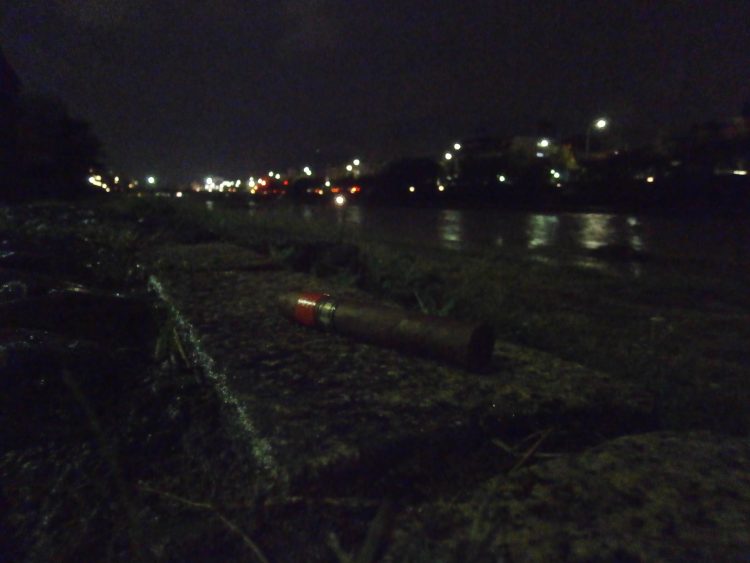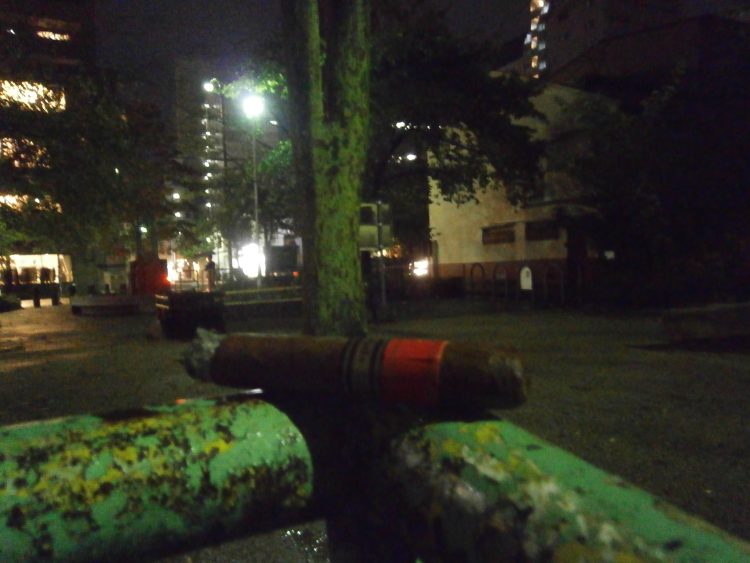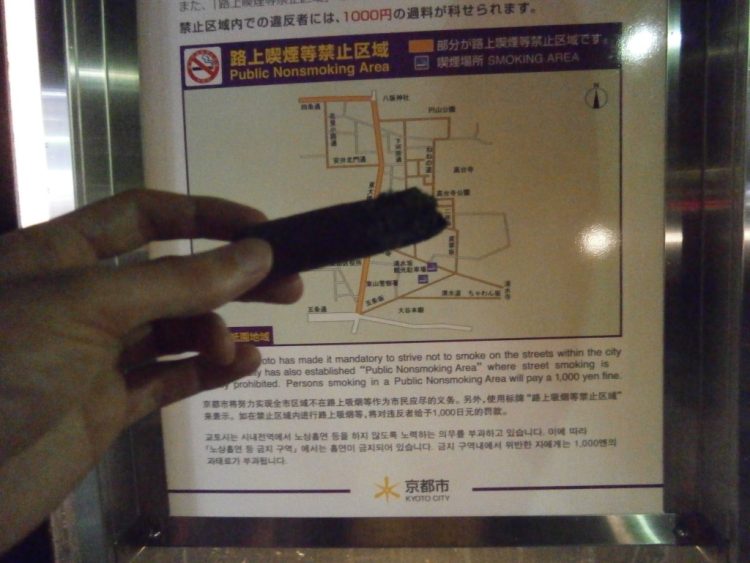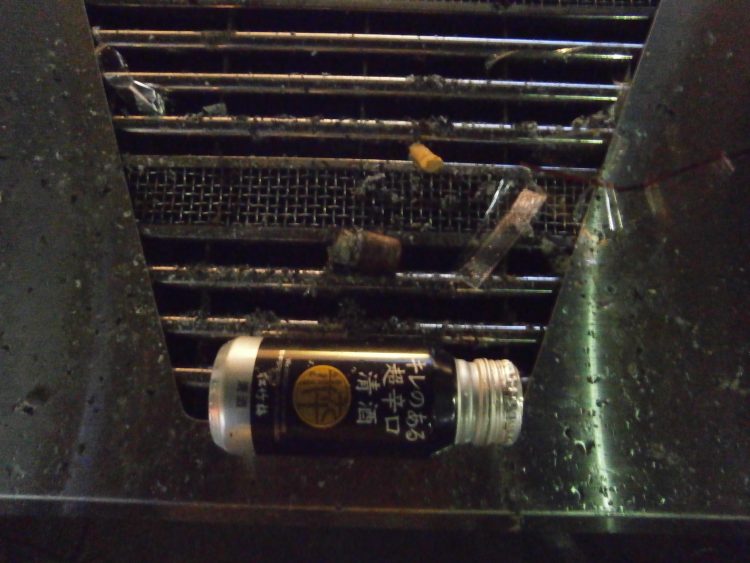We open on the waterfront in Kyoto, Japan. Dark. Wet. Beneath the substantial canopy of a twenty four spoke umbrella a man, young, but with a face lined and leathered from decades of abuse, struggles to light a Partagás Serie D No. 2, Edición Limitada 2003.
Apologies in advance for the picture quality on this one folks – low light conditions, street photography, and the constant threat of attack by sewer rat are very much in effect. You may even be subjected to the greatest cigar blog photograph offence: a high resolution picture of my gnarled hands, hangnails and all.
The cigar does not begin well, with sulphur on the front palette, although the aftertaste does have a slight dirty honeydew that may become a thing. I’m willing to cut this one a fair bit of slack – it was sitting on a rock for several minutes in a light drizzle while I took about twenty test photographs trying figure out what settings looked best in the moonlight, and then lit one spark at a time by a lighter that refused to offer the barest wind resistance; it has a right to be a bit temperamental.
I’m pairing this with a randomly selected Japanese convenience store drink, name unknown (which is to say, “name written in characters”). The can boasts that “[they] introduce a new way to enjoy sake with this product.” It’s a mild, sweet nihonshu. Not bad at all.
For the uninitiated, sake is the general Japanese term for alcohol, and technically covers everything from beer to wine to highballs, although more usually it refers to shōchū and nihonshu, the two main genres of Japanese fermented rice drink. Nihonshu is what we in the west know as sake. Shōchū is a rougher, meaner, more vodka-ish sort of beverage, that’s usually drunk mixed with lemonade or similar. The drink that I am drinking as I write this is nihonshu, and as mild and refined a fermented rice drink as one can buy in a can from 7-11. Nihonshu has a bit of an image problem in Japan, namely that only old men really drink it. I suppose that’s why they’re presenting us with a new way to enjoy it: for the kids.
The cigar has mellowed out nicely, with flavours of wood, hay, wet earth, and perhaps a hint somewhere of large horses. Clydesdales. I was last in Japan in 2010, when raw beef liver was a popular delicacy. In 2011 it was banned after a few cases of e-coli poisoning. It has largely been replaced with raw horse liver. True fact.
My shoes soaked after a kilometre or so of leaping from stone to stone over the little creeks that flow into the river from storm water outlets and other gutters, I leave the riverbank and head up to the street that runs parallel to it, one of Kyoto’s traditional nightlife strips, filled with little bars and seedy alleys. I’m starting at the quiet end, where there are still a few residential buildings, pedestrians are scarce, and what bars there are hide themselves behind calligraphy signs and wooden panels. Further along the strip I will find bars for tourists and teenage party animals, but these are not them; these are geisha bars, for the bosses with the money and the inclination to fulfil the ultimate Japanese masculine fantasy: one night as a samurai.
Entering a more heavily trafficked part of the strip, I detect that something is up: there are pedestrians here, and unusually for Japan none of them seem to be smoking, and even more unusually, there are seats and full ashtrays outside the convenience stores. It’s not until I pass a little glassed in smoking area that I realise with a start that what I am doing is entirely illegal. Japan is a country where, by in large, you can smoke anywhere you want: bars, restaurants, hotel rooms, and hospitals all allow smoking inside to some degree. The only place you can’t smoke is on the streets. Generally this is limited to busy streets during rush hour, although in this instance it appears to cover the entire central tourist district of Kyoto. The fine for violators, admittedly, works out to around ten Australian dollars, but I don’t have my passport on me and it seems like it would be a hassle to rumble with the jacks, so I retreat into the smoking area.
I was there when the no-smoking-on-the-street laws were introduced in Osaka, and I remember the public awareness campaign that preceded them. In Australia we have endured three decades of increasingly escalating anti-smoking legislation, always justified in the name of the public health, to mitigate the burden that the phlegmatic death throes of smokers place on our medical infrastructure. In Japan their smoking bans were introduced for the good of Prada jackets. The flyers showed a cartoon of a man being shocked to find a small hole in his overcoat: “don’t smoke in a crowd” the caption said “coats are expensive.” Cigarettes here are four dollars a pack. There was outcry a couple of years ago when they raised the price from three.
Two inches remain, and the cigar is growing bitter. Readers will be surprised to learn that a public smoking area in the rain (the bins are sheltered, the smokers are not) is not conducive to the slow, meditative enjoyment of a double corona. I wish I could find a Japanese flavour for you in here: edamame, miso, something with umami, but no, everything in this cigar is of the earth: dirt, wood smoke, and wildfire.
While smoking may be marginally restricted, public drinking in Japan remains fully unregulated and a matter of national pride, a fact that one of my fellow hedonists is celebrating vigorously, heading to the Family Mart across the way for a fresh beer in between each cigarette. By my count he’s on his fourth in less than half an hour.
The cigar has reached the bitter nub, where only tar remains. The smoke is drifting up into the canopy of my umbrella, where it pools and gets in my hair. Taking inspiration from my cohort, and with the nihonshu can long exhausted, I think it might be time I visited the Family Mart and find myself a little something to wash the asphalt from my palette. I bin the cigar in the anonymous dirty ashcan so thoughtfully provided by the municipal government – an ashcan that I imagine has seen very few Cohiba Lanceros, very few Cuban Davidoffs, and probably only one Partagás Serie D No. 2.
A good cigar. Better than a PSD4.
Partagás Serie D No. 2 Edición Limitada 2003 on the Cuban Cigar Website



